Electricity distribution industry leads in terms of number of establishments
The total number of establishments engaged in electricity, gas, steam and air conditioning supplyin the formal sector of the economy reached 261, according to the final results of the 2015 Annual Survey of Philippine Business and Industry (ASPBI).
Among the three industries of the sector, distribution of electricity recorded as the highest with 154 establishments or 59.0 percent of the total. Electric power generation followed with 104 establishments or 39.8 percent of the total. Transmission of electricity reported only a total of three (3) establishments or 1.2 percent of the total.
Figure 1 shows the percent distribution of all electricity, gas, steam and air conditioning supplyestablishments by industry sub-class in 2015.
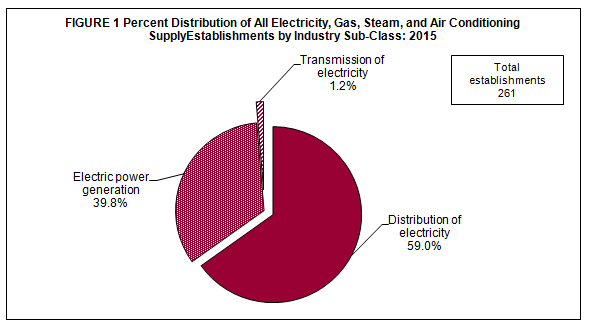
Total employment of the sector reaches 46,650
Total employment generated by electricity, gas, steam, and air conditioning supply establishments reached 46,650 in 2015, of which all were paid employees.
At the industry level, distribution of electricity reported the highest number of workerswith 32,488 or 69.6 percent of the total. Electric power generation followed next with9,553 workers (20.5%) and transmission of electricity came as the third top employer with 4,629 workers (9.9%).
Figure 2 shows the distribution of employment for all electricity, gas, steam, and air conditioning supply establishmentsby industry sub-class in 2015.
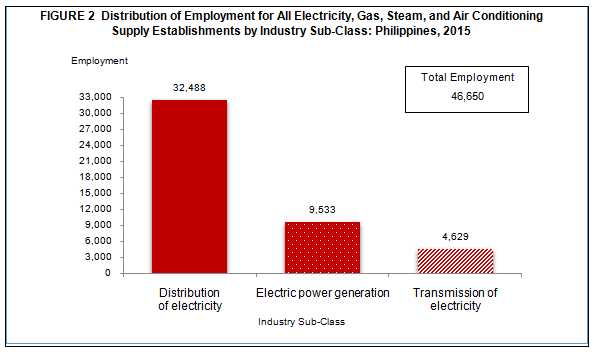
The average number of workers per establishment for the sector was recorded at 179. Transmission of electricity recordedthe highest average number of employment at 1,543. This was followed by distribution of electricity and electric power generationwith 211 and 92 workers per establishment, respectively.
Electric power generation pays the highest average annual compensation
Total compensation paid by the sector which consists of gross salaries and wages, separation and retirement/terminal pay, gratuities, employers’ contribution to SSS/GSIS, and other benefits amounted toPHP34.6billion in 2015. This is translated to an average annual compensation of PHP742,696 per employee.
At the industry level, electric power generation paid the highest average annual compensation at PHP1.2 million. Transmission of electricity followed with PHP0.8 million while distribution of electricity paid PHP0.6 million.
Figure 3 shows the average annual compensation of employees for all electricity, gas, steam, and air conditioning supply establishments by industry sub-class in 2015.
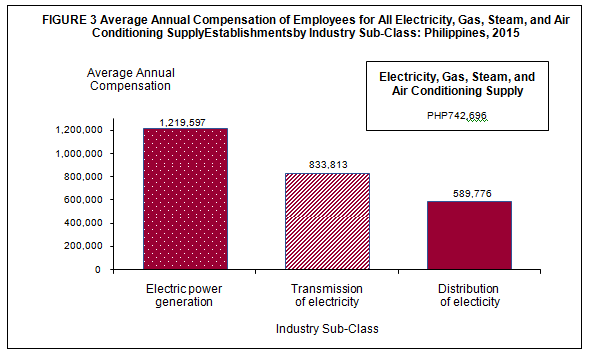
Distribution ofelectricity industry generates highest value of output
Total value of output generated by the sector forestablishments amounted to PHP751.4 billion.
Distributionof electricity generated the highest value of output amounting to PHP469.1 billion (62.4%). Electric power generation reported the second highest value of output of PHP236.5 billion (31.5%). Transmission of electricity followed with total value of output of PHP45.7 billion (6.1%).
Figure 4 shows the percentage distribution of value of output for all electricity, gas, steam and air conditioning supply establishments by industry sub-class in 2015.
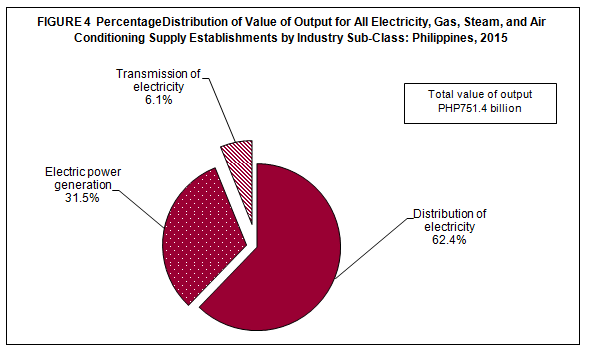
Distribution of electricity industry incurs the highest expense in 2015
Total expense, including compensation, incurred in business operation of electricity, gas, steam, and air conditioning supply establishments amounted to PHP657.7 billion in 2015.
Distribution of electricity was the highest spender worth PHP433.2 billion (65.9%). Electric power generation followed with PHP201.0 billion (30.6%). Transmission of electricity emerged as the least industry spender with PHP23.5 billion or 3.6 percent of the total.
Income per expense ratio for the sector is 1.21
Income per expense ratio for the sector in 2015 was recorded at 1.21, indicating that for every peso spent PHP1.21 was realized in terms of income.
Transmission of electricity registered the highest return of 1.96, higher than the sector’s average. Electric power generation recorded an income per peso expense of 1.40 while distribution of electricity registered at 1.08.
Electric power generation industry reports highest share to value added
Value added,defined as gross output less intermediate input, generated by allelectricity, gas, steam and air conditioning supply establishments reached PHP206.3 billion in 2015.
Electric power generation reported the highest value added amounting to PHP98.6 billion (47.8%). Distribution of electricity with PHP73.5 billion (35.6%) was the next highest value added contributor. Transmission of electricity placed third with PHP34.2 billion (16.6%).
Labor productivity for the sector posts PHP4.4 million per worker
The ratio of value added to total employment, a simple measure of labor productivity, was estimated at PHP4.4 million per worker in 2015.
At the industry level, electric power generation was the most productive with recorded labor productivity of PHP10.3 million per worker. Industries related to transmission and distribution of electricity placed second and third with labor productivity of PHP7.4 and PHP2.3 million per worker, respectively.
Figure 5 shows the labor productivity of all electricity, gas, steam, and air conditioning supply establishments by industry sub-class in 2015.
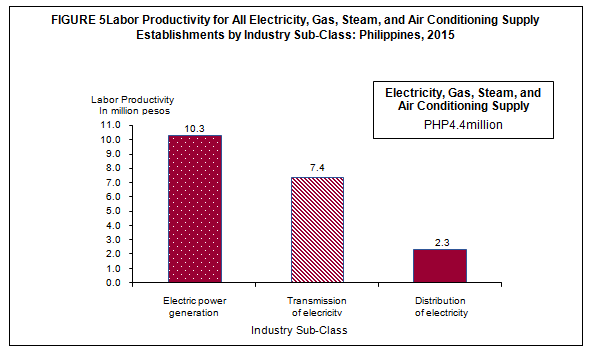
Gross addition to tangible fixed assets amounts to PHP31.5billion
Gross addition to tangible fixed assets, defined as capital expenditures less sale of fixed assets, was estimated at PHP31.5 billion in 2015.
More than 60.0 percent of the gross addition to tangible fixed assets reported by the sector was accounted by distributionof electricity with PHP19.6 billion (62.2%). Electric power generation followed with PHP11.9 billion (37.8%).
Total subsidy received by the sector in 2015 reaches PHP11.0 billion
Total subsidy provided by the government to support the business operation of electricity, gas, steam and air conditioning supply establishments was estimated at PHP11.0 billion in 2015.
Distribution of electricity received the highest subsidy amounting to PHP7.3 billion (66.6%) in 2015. This was followed by electric power generation with PHP3.7 billion (33.4%)
TECHNICAL NOTES
Introduction
This Special Release presents the final results of the 2015Annual Survey of Philippine Business and Industry for allElectricity, Gas, Steam and Air Conditioning Supply(Sector D) establishments.
The 2015 ASPBI is one of the designated statistical activities of the Philippine Statistics Authority (PSA). Data collected from the survey provide information on the levels, structure, performance, and trends of economic activities of the formal sector in the entire country for the year 2015. The 2015 Survey onInformation and Communication Technology (SICT) was undertaken as a rider to this survey.
The survey was conducted nationwide in 2016 with the year 2015 as the reference period of data, except for employment which is as of November 15, 2015.
Establishment Data Management System (EDMS) was still utilized in the decentralized processing of the 2015 ASPBI questionnaires in the provinces as well as the online accomplishment of questionnaire through PSA website.
Data are presented at the national and industry sub-class or 5-digit 2009 Philippine Standard Industrial Classification (PSIC).
In response to the needs of stakeholders, PSIC D35100 – generation, transmission and distribution of electricity was broken down into detailed sub-class to provide better analysisas follows:
|
· D35101 |
Electric power generation |
|
· D35102 |
Transmission of electricity |
|
· D35103 |
Distribution of electricity |
Data are also generated at the regional level.
Legal Authority
The conduct of the 2015 ASPBI is authorized under Republic Act 10625 known as the Philippine Statistical Act of 2013 - Reorganizing and strengthening of the Philippine Statistical System (PSS), its agencies and instrumentalities.
Scope and Coverage
The 2015 ASPBI covered establishments engaged in 18 economic sectors classified under the 2009 PSIC, namely:
- Agriculture, Forestry and Fishing (A)
- Mining and Quarrying (B)
- Manufacturing (C)
- Electricity, Gas, Steam, and Air Conditioning Supply (D)
- Water Supply; Sewerage, Waste Management and Remediation Activities (E)
- Construction (F)
- Wholesale and Retail Trade; Repair and Maintenance of Motor Vehicles, Motorcycles (G)
- Transportation and Storage (H)
- Accommodation and Food Service Activities (I)
- Information and Communication (J)
- Financial and Insurance Activities (K)
- Real Estate Activities (L)
- Professional, Scientific and Technical Activities (M)
- Administrative and Support Service Activities (N)
- Education (P)
- Human Health and Social Activities (Q)
- Arts, Entertainment and Recreation (R)
- Other Service Activities (S)
The survey was confined to the formal sector of the economy, which consists of the following:
- Corporations and partnership
- Cooperatives and foundations
- Single proprietorship with employment of 10 and over
- Single proprietorships with branches
Hence, the 2015 ASPBI covered only the following economic units:
- All establishments with total employment (TE) of 10 and over, and;
- All establishments with TE of less than 10, except those establishments with Legal Organization = 1 (single proprietorship) and Economic Organization = 1 (single establishment), that are engaged in economic activities classified according to the 2009 Philippine Standard Industrial Classification (PSIC).
Frame of Establishments
The frame for the 2015 ASPBI was extracted from the 2015 List of Establishments (LE). The estimated number of establishments in operation in the country in 2015 totaled to 909,786. About 259,386 establishments (29.0% of the total establishments) belong to the formal sector of which 223,821 (86.3%) comprised the establishment frame. This frame was used to draw the sample establishments for the survey.
Unit of Enumeration
The unit of enumeration for the 2015 ASPBI is the establishment. Anestablishment is defined as an economic unit under a single ownership or control which engages in one or predominantly one kind of activity at a single fixed location.
Classification of Establishments
An establishmentis categorized by its economic organization, legal organization, industrial classification, employment size, and geographic location.
Economic Organization refers to the organizational structure or role of the establishment in the organization. An establishment may be single establishment, branch, establishment and main office with branches elsewhere, main office only, and ancillary unit other than main office.
Legal Organization refers to the legal form of the economic entity which owns the establishment. An establishment may be single proprietorship, partnership, government corporation, stock corporation, non-stock corporation, and cooperative.
Industrial classification of an economic unit was determined by the activity from which it derives its major income or revenue. The 2009 PSIC was utilized to classify economic units according to their economic activities.
Size of an establishmentis determined by its total employment (TE) as of specific date.
Geographic Classification refers to the classification by geographic area using the Philippine Standard Geographic Code (PSGC) classification.
Methodology
Sampling Design
The 2015 ASPBI used stratified systematic sampling with five-digit PSIC serving as first stratification variable and TE as the second stratification variable.
All establishments in the formal sector for the Electricity, Gas, Steam and Air Conditioning SupplySector were covered on a 100 percent or on a certainty basis because of their relatively small number.
The estimate of the total of a characteristic  for the certainty employment stratum in an industry domain in each geographic domain (region) is
for the certainty employment stratum in an industry domain in each geographic domain (region) is

where:
p= 1, 2,..., 17 regions (geographic domains)
xpj= value of the jth establishment in an industry domain within each region
j= 1, 2, 3, …,mp establishments
mp= number of establishments in an industry domain within each region
National level estimate of a characteristics by industry domain ( ) was obtained by aggregating separately the estimates ( ) for the particular industry domain from all the regions.

To address the data needs of stakeholders for a more detailed industrial classification, D35100 was split and assigned with sub-industry codes as follows:
|
2009 PSIC Code |
Assigned Industry Code |
Description |
|
D35100 |
D35100 |
Generation, transmission and distribution of electricity |
|
|
D35101 |
Electric power generation |
|
|
D35102 |
Transmission of electricity |
|
|
D35103 |
Distribution of electricity |
The newly assigned industry codes will be used to generate data for these sub-industries.
Response Rate
Response rate for Electricity, Gas, Steam and Air Conditioning Supply Sector was 97.4 percent (268 out of 275 establishments). This included receipts of "good" questionnaires, partially accomplished questionnaires, reports of closed, moved out or out of scope establishments.
Reports of the remaining non-reporting establishments were taken from other available administrative data sources and financial statements from Securities and Exchange Commission (SEC). However, there were establishments which were found to be duplicates, out-of-scope and out of business in 2015
Limitation of Data
Only the formal sector was covered in the survey.
Concepts and Definitions of Terms
Economic activity is the establishment’s source of income. If the establishment is engaged in several activities, its main economic activity is that which earns the biggest income or revenue.
Total employment is the number of persons who worked in for the establishment as of November 15, 2015.
Paid employees are all persons working in the establishment and receiving pay, as well as those working away from the establishment paid by and under the control of the establishment. Included are all employees on sick leave, paid vacation or holiday. Excluded are consultants, home workers, receiving pure commissions only, and workers on indefinite leave.
Compensation is the sum of salaries and wages, separation/retirement/terminal pay, gratuities, and payments made by the employer in behalf of the employees such as contribution to SSS/GSIS, ECC, PhilHealth, Pag-ibig, etc.
Salaries and wages are payments in cash or in kind to all employees, prior to deductions for employee’s contributions to SSS/GSIS, withholding tax, etc. Included are total basic pay, overtime pay and other benefits.
Income or Revenue refers to cash received and receivables for goods/products and by-products sold and services rendered.
E-commerce refers to the selling of products or services over electronic systems such as Internet Protocol-based networks and other computer networks. Electronic Data Interchange (EDI) network, or other on-line system. Excluded are orders received from telephone, facsimile and e-mails.
Expense refers to cost incurred in an enterprise effort to generate revenue, representing the cost of doing business. This is treated on a consumed basis. It excludes cost incurred in the acquisition of income generating assets.
Intermediate expense are expenditures incurred in the production of goods such as materials and supplies used; fuels, lubricants, oils and greases used; electricity and water purchased, and industrial services done by others.
Value addedis gross output less intermediate input. Gross output for the electricity, gas, steam, and air conditioning supplysector is value of output plusincome from non-industrial services done for others (except rent income from land). Intermediate input is intermediate expense plus expense for non-industrial services done by others (except rent expense for land) and all other expenses.
Value of outputrepresents the sum of the receipts from revenue from main activity, income from industrial services done for others, goods sold in the same condition as purchased less the cost of goods sold and value of fixed assets produced on own account.
Gross addition to tangible fixed assets is equal to capital expenditures less sale of fixed assets, including land.
Change in inventories is equivalent to the value of inventories at the end of the year less the value of inventories at the beginning of the year.
Subsidies are all special grants in the form of financial assistance or tax exemption or tax privilege given by the government to aid and develop an industry.
ROMEO S. RECIDE
